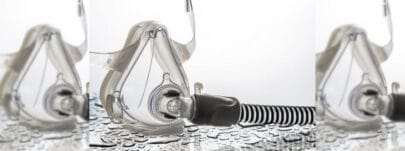
Why You Get CPAP Rainout (Even With a Heated Hose) and How to Fix It
A heated humidifier can significantly improve comfort levels when using APAP, BiPAP or CPAP therapy to treat obstructive sleep apnea.
Studies report that 70% of PAP users can struggle with nasal congestion , dry mouth, sore throat, and other side effects, resulting from the cool, drier air delivered by a CPAP device. Humidification helps ease these issues and makes CPAP a more comfortable experience, This additional comfort can encourage compliance.
However, addressing CPAP water in the hose is important when using a heated humidifier, as adding humidification can introduce a problem with rainout.
What Is Rainout?
Most modern APAP, BiPAP or CPAP devices are equipped with a heated humidifier. However, when the heated air travels through the hose, the air can cool and condense into water droplets. This water may flow down the hose and into the mask.
The sensation of water on your face is uncomfortable and can wake you, as can gurgling noises from water collecting in the hose. A heated hose, such as the ResMed Climate Line, reduces the risk of rainout by maintaining a consistent temperature as the air flows from the heated humidifier to the mask. However, you can still experience CPAP rainout even with a heated hose.
Why You Could Still Have CPAP Rainout Even With a Heated Hose
Heated tubing manages humidification according to the ambient temperature of the room to reduce rainout and provide additional comfort. However, if there is still a difference between room temperature and the temperature of the air in the hose you may experience rainout.
How to Fix Issues with CPAP Rainout Even With a Heated Hose Employed
While using a heated humidifier and hose helps reduce rainout, it may not resolve the issue entirely. You may still need to make a few temperature adjustments and other little tweaks to your CPAP hose connector.
1. Adjust the Settings on the Heated Humidifier
If the setting on the heated humidifier does not account for the climatic conditions where you live, then you could still experience CPAP rainout even with a heated hose. If you live in a particularly humid or hot climate, the heated humidifier may need to be set to a higher temperature.
On the other hand, if you set the temperature of the humidifier too high for your bedroom environment, the heated air could lack moisture and result in CPAP side effects like dry mouth and nasal congestion, which the introduction of humidification is designed to prevent.
You should consult your healthcare provider or CPAP equipment supplier if you are experiencing CPAP rainout even with a heated hose and wish to adjust the settings on your heated humidifier.
2. Adjust the Overnight Temperature for Your Bedroom
Before adjusting the setting on your heated humidifier, you may want to try adjusting your overnight room temperature first to see if this reduces any CPAP rainout even with a heated hose.
If the air temperature in your bedroom is cooler than the temperature of the air passing through the hose, then you are likely to experience rainout. Nudging the thermometer up a little may help level the ambient temperature in the room to that of the air in the heated tubing.
This is a simple fix without needing to make adjustments to the heated humidifier setting. It may take a little trial and error to arrive at the right room temperature setting to remove rainout.
However, some people prefer a cooler room temperature as they find it promotes sleep. In this case, adjusting the heated humidifier may be the better option.
3. Reposition Your CPAP Device
Another straightforward solution to avoid the effects of CPAP rainout even with a heated hose is to reposition your device.
A CPAP device is often kept on a bedside stand. If rainout is an issue and water continues to get into your mask, then move the CPAP device to a lower shelf on your bedside stand. Alternatively, use another stand, table, or shelving unit where your CPAP device can sit overnight and is below the level of your head.
When you position the CPAP device below your head, you use gravity to ensure any droplets of water formed due to condensation in the hose flow down toward the device rather than up into your mask.
This can be a good get-around solution to the uncomfortable impact of rainout while you make adjustments to the room temperature or heated humidifier setting. Rainout can threaten compliance with CPAP therapy, so any efforts to reduce the problem are worth a try.
4. Try a Hose Jacket
Just as you might add an extra layer of clothing for warmth, you can wrap your heated tubing in an extra layer if rainout remains an issue.
A hose jacket wraps around the CPAP hose, acting as a form of insulation to mitigate against a cooler air temperature in the room. Such accessories can be beneficial as part of better CPAP hose management.
Of course, you could tuck the hose under your blankets for a similar insulation effect. However, this may not be so effective if you tend to move a lot during sleep and pull the blankets off the hose.
5. Auto-Adjusting Technology
Some devices like the ResMed S10 or S11 Series have auto-adjusting technology. This monitors the temperature of the air reaching your mask against the ambient room temperature and changes the humidifier and hose temperatures as required. Therefore, an optimal temperature is maintained to prevent rainout and provide additional comfort.
CPAP rainout even with a heated hose is an uncomfortable experience and threatens your motivation to stick to therapy. You might reposition the CPAP device to ensure moisture in the hose flows down to the CPAP device and away from the mask.
However, adjustments to room temperature, hose temperature, and the settings on the heated humidifier can prevent the condensation that leads to rainout. You can discuss potential adjustments with your healthcare provider to ensure they are appropriate for your CPAP treatment.



